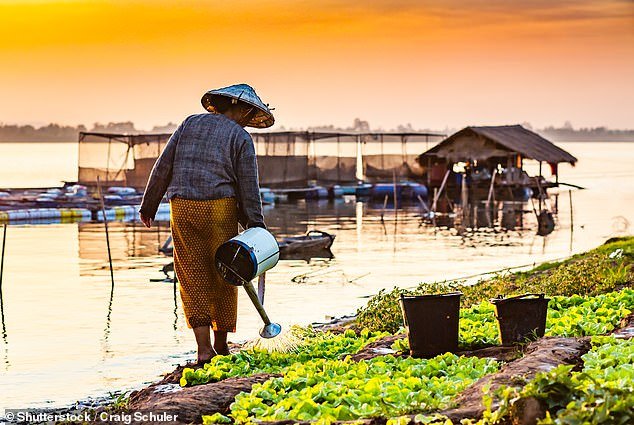Floating in the middle of the Mekong River current, we hold our breath. Our guide, in the kayak next to us, points out where we should look.
And there it is: a whooshing noise, like a great sigh or sneeze, and the flash of a bright grey back, which curls out of the water and disappears again. It’s a rare Irrawaddy dolphin. And then another. And another. Sometimes they appear just a few metres from the kayak, almost within touching distance.
Irrawaddy dolphins, named after Myanmar’s Irrawaddy River, are found here in the Mekong in Cambodia. They are more shy than their bottlenose cousins and less given to showy acrobatics, but their elusive nature makes them all the more fascinating.
Instead of a long, bottle-shaped nose, they have a bulging forehead and a short, upturned beak that gives them a cute appearance. When the river’s waters are low, from January to May, they gather in nine deep pools along a stretch of the Mekong that runs from the Laotian border south to the Cambodian town of Kratie, a six-hour minibus ride northeast of the capital, Phnom Penh.
The current carries us downriver past small islands and flooded forest. We stop to swim in the clean, clear water and eat sticky rice while our guide explains the challenges these critically endangered dolphins face, such as hydroelectric dams built upriver that destroy their habitat. There are now fewer than 100 dolphins left in the Mekong, although fortunately two calves were born this year.
Simple living: Annabel Venning travels to Cambodia to explore some of its natural wonders. Above: A woman watering plants on the banks of the Mekong River
That evening, we watched the sun set while sipping a Mekong Sunset cocktail on the balcony of our guesthouse, Sorya, which runs the kayaking tours. Angkor Wat, near Siem Reap, put Cambodia on the world tourist map, but its landscape and wildlife are equally fascinating.
Just 13 kilometres from Siem Reap lies the Pearaing Biodiversity Conservation Centre at the northern end of Tonle Sap Lake, where we can see painted-billed pelicans, painted herons, milky storks and ospreys.
Conservation is in constant conflict with development in Cambodia, which has lost 15 percent of its forests in ten years. Illegal loggers and private developers wreak havoc, but there remains intact forest where some of the few remaining wild Asian elephants roam, along with porcupines and pangolins, civet cats, sun bears and clouded leopards.

There is still untouched rainforest in Cambodia, where some of the few remaining wild Asian elephants roam, reveals Annabel

“Angkor Wat, near Siem Reap, put Cambodia on the world tourist map, but its landscape and wildlife are equally fascinating,” writes Annabel. Above are the Cardamom Mountains
You can help protect them by visiting the country’s community-based ecotourism projects. We visited one in Steung Areng village, supported by Wildlife Alliance, which protects the Central Cardamom Mountains National Park, Southeast Asia’s largest continental rainforest.
After a five-hour taxi ride south from Phnom Penh, my friend and I climbed onto the back of a motorbike to the starting point. After three hours of sweaty climbing through the jungle, we reached a valley where a waterfall cascades into a pool. We swam, ate rice cooked in banana leaves and slept in hammocks strung between the trees, waking up to the jungle orchestra.
We don’t see elephants, bears or pangolins, but hornbills fly below us and monkeys run around in the treetops. We return to the starting point and wait for our motorbikes to return to Steung Areng.

Annabel sees Irrawaddy dolphins, rare in Cambodia’s Mekong River

On a visit to Koh Rong Sanloem Island, above, Annabel swims among bioluminescent plankton.
Cambodian houses have open fronts and the people are as open as their homes. It’s not long before we are invited inside and offered drinks. Despite widespread poverty, the warmth of the Cambodian people makes it a safe and friendly place to travel.
Next we head to the islands off the south coast. First, Koh Thmei, where we stay at its only resort: eight charming beach huts along a palm-fringed beach.
Next, we headed to Koh Rong Sanloem, where we paddled out to watch the sunset and swim among bioluminescent plankton. It’s like our fingertips were glowing. Like plankton, Cambodia glows in many ways.
You Might Also Like
- Airport worker delights the internet after recording a hilarious message for plane passenger who left their iPad behind on a flight
- How to become a digital nomad – and make a living from the BEACH: Experts reveal top tips for a life working anywhere on the planet – from combatting loneliness to applying for visas
- Ryanair’s war with online travel agents continues: Carrier accuses On The Beach of overcharging for flight changes by 117% and eSky of demanding 33 euros to cancel flights ‘that cannot be cancelled’
- You ate burritos really bad! Etiquette expert William Hanson explains how to eat the Mexican meal correctly, including what to do in case of a ‘spill’

